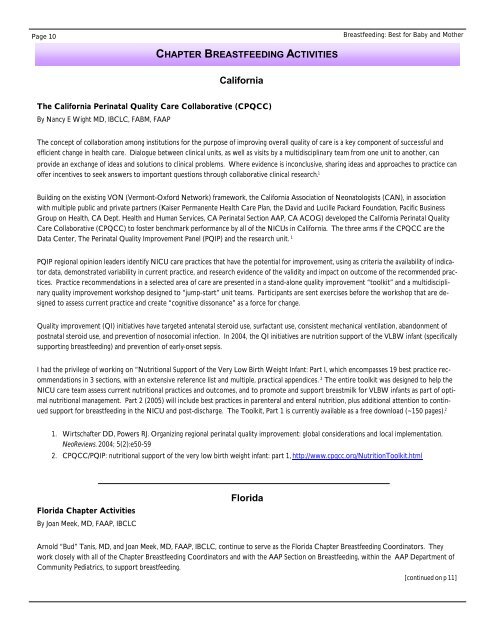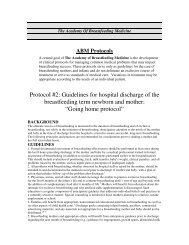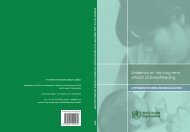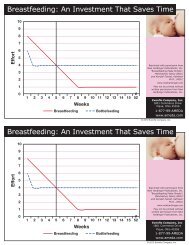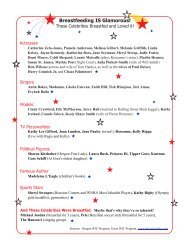Congenital Tongue-Tie and Its Impact on Breastfeeding - New ...
Congenital Tongue-Tie and Its Impact on Breastfeeding - New ...
Congenital Tongue-Tie and Its Impact on Breastfeeding - New ...
Create successful ePaper yourself
Turn your PDF publications into a flip-book with our unique Google optimized e-Paper software.
Page 10<strong>Breastfeeding</strong>: Best for Baby <str<strong>on</strong>g>and</str<strong>on</strong>g> MotherCHAPTER BREASTFEEDING ACTIVITIESCaliforniaThe California Perinatal Quality Care Collaborative (CPQCC)By Nancy E Wight MD, IBCLC, FABM, FAAPThe c<strong>on</strong>cept of collaborati<strong>on</strong> am<strong>on</strong>g instituti<strong>on</strong>s for the purpose of improving overall quality of care is a key comp<strong>on</strong>ent of successful <str<strong>on</strong>g>and</str<strong>on</strong>g>efficient change in health care. Dialogue between clinical units, as well as visits by a multidisciplinary team from <strong>on</strong>e unit to another, canprovide an exchange of ideas <str<strong>on</strong>g>and</str<strong>on</strong>g> soluti<strong>on</strong>s to clinical problems. Where evidence is inc<strong>on</strong>clusive, sharing ideas <str<strong>on</strong>g>and</str<strong>on</strong>g> approaches to practice canoffer incentives to seek answers to important questi<strong>on</strong>s through collaborative clinical research. 1Building <strong>on</strong> the existing VON (Verm<strong>on</strong>t-Oxford Network) framework, the California Associati<strong>on</strong> of Ne<strong>on</strong>atologists (CAN), in associati<strong>on</strong>with multiple public <str<strong>on</strong>g>and</str<strong>on</strong>g> private partners (Kaiser Permanente Health Care Plan, the David <str<strong>on</strong>g>and</str<strong>on</strong>g> Lucille Packard Foundati<strong>on</strong>, Pacific BusinessGroup <strong>on</strong> Health, CA Dept. Health <str<strong>on</strong>g>and</str<strong>on</strong>g> Human Services, CA Perinatal Secti<strong>on</strong> AAP, CA ACOG) developed the California Perinatal QualityCare Collaborative (CPQCC) to foster benchmark performance by all of the NICUs in California. The three arms if the CPQCC are theData Center, The Perinatal Quality Improvement Panel (PQIP) <str<strong>on</strong>g>and</str<strong>on</strong>g> the research unit. 1PQIP regi<strong>on</strong>al opini<strong>on</strong> leaders identify NICU care practices that have the potential for improvement, using as criteria the availability of indicatordata, dem<strong>on</strong>strated variability in current practice, <str<strong>on</strong>g>and</str<strong>on</strong>g> research evidence of the validity <str<strong>on</strong>g>and</str<strong>on</strong>g> impact <strong>on</strong> outcome of the recommended practices.Practice recommendati<strong>on</strong>s in a selected area of care are presented in a st<str<strong>on</strong>g>and</str<strong>on</strong>g>-al<strong>on</strong>e quality improvement “toolkit” <str<strong>on</strong>g>and</str<strong>on</strong>g> a multidisciplinaryquality improvement workshop designed to “jump-start” unit teams. Participants are sent exercises before the workshop that are designedto assess current practice <str<strong>on</strong>g>and</str<strong>on</strong>g> create “cognitive diss<strong>on</strong>ance” as a force for change.Quality improvement (QI) initiatives have targeted antenatal steroid use, surfactant use, c<strong>on</strong>sistent mechanical ventilati<strong>on</strong>, ab<str<strong>on</strong>g>and</str<strong>on</strong>g><strong>on</strong>ment ofpostnatal steroid use, <str<strong>on</strong>g>and</str<strong>on</strong>g> preventi<strong>on</strong> of nosocomial infecti<strong>on</strong>. In 2004, the QI initiatives are nutriti<strong>on</strong> support of the VLBW infant (specificallysupporting breastfeeding) <str<strong>on</strong>g>and</str<strong>on</strong>g> preventi<strong>on</strong> of early-<strong>on</strong>set sepsis.I had the privilege of working <strong>on</strong> “Nutriti<strong>on</strong>al Support of the Very Low Birth Weight Infant: Part I, which encompasses 19 best practice recommendati<strong>on</strong>sin 3 secti<strong>on</strong>s, with an extensive reference list <str<strong>on</strong>g>and</str<strong>on</strong>g> multiple, practical appendices. 2 The entire toolkit was designed to help theNICU care team assess current nutriti<strong>on</strong>al practices <str<strong>on</strong>g>and</str<strong>on</strong>g> outcomes, <str<strong>on</strong>g>and</str<strong>on</strong>g> to promote <str<strong>on</strong>g>and</str<strong>on</strong>g> support breastmilk for VLBW infants as part of optimalnutriti<strong>on</strong>al management. Part 2 (2005) will include best practices in parenteral <str<strong>on</strong>g>and</str<strong>on</strong>g> enteral nutriti<strong>on</strong>, plus additi<strong>on</strong>al attenti<strong>on</strong> to c<strong>on</strong>tinuedsupport for breastfeeding in the NICU <str<strong>on</strong>g>and</str<strong>on</strong>g> post-discharge. The Toolkit, Part 1 is currently available as a free download (~150 pages). 21. Wirtschafter DD, Powers RJ. Organizing regi<strong>on</strong>al perinatal quality improvement: global c<strong>on</strong>siderati<strong>on</strong>s <str<strong>on</strong>g>and</str<strong>on</strong>g> local implementati<strong>on</strong>.NeoReviews. 2004; 5(2):e50-592. CPQCC/PQIP: nutriti<strong>on</strong>al support of the very low birth weight infant: part 1, http://www.cpqcc.org/Nutriti<strong>on</strong>Toolkit.htmlFlorida Chapter ActivitiesBy Joan Meek, MD, FAAP, IBCLCFloridaArnold “Bud” Tanis, MD, <str<strong>on</strong>g>and</str<strong>on</strong>g> Joan Meek, MD, FAAP, IBCLC, c<strong>on</strong>tinue to serve as the Florida Chapter <strong>Breastfeeding</strong> Coordinators. Theywork closely with all of the Chapter <strong>Breastfeeding</strong> Coordinators <str<strong>on</strong>g>and</str<strong>on</strong>g> with the AAP Secti<strong>on</strong> <strong>on</strong> <strong>Breastfeeding</strong>, within the AAP Department ofCommunity Pediatrics, to support breastfeeding.[c<strong>on</strong>tinued <strong>on</strong> p 11]


